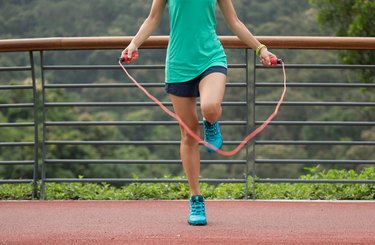
Physical activity, such as jumping rope, should make your body feel energized, strong and pain-free. But too often, the bad effects of skipping rope, such as improper shoes, the wrong surface or flaws in technique, cause people to quit before they really give this fantastic form of cardio a chance.
Benefits of Jumping Rope
Video of the Day
Health.gov's Physical Activity Guidelines for Americans recommends that adults get 150 minutes a week of moderate-intensity cardio or 75 minutes a week of vigorous-intensity aerobic activity. Participating in physical activities, such as jumping rope, can help you meet these guidelines and contribute positively to your overall health.
Video of the Day
The benefits of skipping rope for weight loss are plentiful, especially when you consider the high calorie burn this form of cardio delivers. Harvard Health Publishing reports that 30 minutes of jumping rope can burn approximately 372 calories in a 155-pound person.
But it's not just the calorie burn that makes this an exercise worth trying; jumping rope also contributes to better heart health, overall physical wellness and a reduction in the incidence of certain diseases. The American Heart Association reports that actively engaging in exercise can prevent you from developing heart disease.
It can also reduce your risk of having a stroke and developing Type 2 diabetes, and because it contributes to better bone health, being active also decreases your risk of injury from falls.
Plus, the American Council of Exercise says that skipping rope can strengthen the calf muscles and improve the elasticity of the surrounding tendons and fascia, which can reduce your risk of lower-leg injuries. This is good news for anyone dealing with joint or muscle pain in and around their knees, ankles, feet or hips.
Bad Effects of Skipping Rope
Just like any other physical activity, there are both pros and cons to this form of aerobic exercise. While many of the bad effects of skipping rope can be resolved, there are some situations where choosing this method of cardio might not be the best option.
If you have existing injuries or chronic pain in your joints, and more specifically your knees, ankles and feet, be sure to ask your doctor or physical therapist if jumping rope is the best exercise for you. According to the Arthritis Foundation, high-impact activities where both feet leave the ground like they do when jumping rope, is not advised for people with tender joints.
With that in mind, if jumping rope is causing too much pain, you might need to try an alternative form of exercise. For knee, hip, ankle and foot joint pain, consider low-impact activities such as swimming, pool jogging or walking, water aerobics, stationary cycling in an easy gear, walking or gentle yoga.
Too much of a good thing, such as daily rope jumping, can also contribute to the bad effects of skipping rope. Make sure to cross-train with other aerobic and strength training activities. And, allow time at the beginning of the workout to perform dynamic stretches, and the end for static stretches.
Tips to Protect Your Joints
To keep your body safe and injury free, especially if you want to jump rope without side effects to your joints, you'll need to be proactive and purposeful in your approach to exercise.
- Keep the rope low. If you're a beginner, you have any joint pain, or you're rehabbing from an injury, aim for low impact movements by keeping the rope low and only bringing your feet slightly off the ground. Remember, you can still benefit from this activity even if you need to reduce the intensity and decrease the range of motion.
- Land softly. This tip is critical for anyone wanting to prevent the bad effects of skipping rope. When you land, avoid hitting the ground too hard. The goal is to be light on the balls of your feet and land softly to absorb the shock.
- Choose a soft surface. Ideally, you should jump on a surface that provides some comfort and support such as the grass, an aerobics floor, a track or gym floor. If possible, avoid jumping rope on a concrete surface. But if this is your only option, consider placing a jump rope mat on the ground. And if you're using this as part of an injury rehab process, stick to a high-rebounding surface.
- Wear appropriate shoes. The shoes you wear can make all the difference. Choose cross-training or running shoes that provide comfort and support for high-impact activities.
- American Council on Exercise: "7 Benefits of Jumping Rope"
- American Heart Association: "American Heart Association Recommendations for Physical Activity in Adults and Kids"
- Arthritis Foundation: "Lower Body Exercises: Dos and Don'ts"
- American Council on Exercise: "Jump Rope Workouts"
- Health.gov: "Physical Activity Guidelines for Americans, 2nd Edition"
- Harvard Health Publishing: "Calories Burned in 30 Minutes for People of Three Different Weights"